Mitigating Built Environment Air Pollution by Green Systems: An In-Depth Review
Abstract
:1. Introduction
2. Methodology
- “Green wall”, “vertical garden”, “living wall”, “urban greenery”, and “green facade”: these terms encompass the various types of vegetation-based systems used in urban environments.
- “Pollution”, “air”, and “pollutant”: these terms relate directly to the primary focus of the study, which is air pollution.
- “Carbon”, “CO2”, “NOx”, “particulate”, “VOC”, and “sequestration”: these terms specify the types of pollutants and processes involved in air quality improvement through green systems.
- “Mitigation”, “system”, and “livestock”: these terms help to capture studies focusing on mitigation strategies and specific application environments like livestock buildings.
- “Biofilter”: this term is crucial for identifying studies that use biological systems to filter and purify air.
- Discussed experimental performance analyses, methodologies, and instruments used to measure pollutant concentrations.
- Quantified the capture of pollutants by botanical biofilters.
- Examined the processes, dynamics, and factors influencing plant capacities.
- Only studies published in the last ten years were included, excluding articles published before 2013.
- Only peer-reviewed articles in scientific journals were considered.
- Only English-language publications were included to ensure consistency and comprehensibility.
- Studies that were too generic or did not focus primarily on green systems, such as those on the life cycle assessment (LCA) of green walls, their thermal properties, or green roof systems, were excluded as they do not pertain to the primary focus of reducing environmental impact through air purification.
3. Technology and Materials
3.1. Green Walls
3.2. Active Green Walls
3.3. Urban Greenery Systems
3.4. Considerations on Plant Species
4. Comparative Analysis of Experimental and Simulation Approaches
4.1. Experimental Analysis of “In Situ” Performance
4.1.1. Indoor Performance Trials
4.1.2. Outdoor Performance Trials
4.1.3. Livestock Farming Area Trials
4.2. Laboratory Tests
4.2.1. Sealed Fumigation Chambers
4.2.2. Plant Characteristics and Purification Capacities
4.2.3. Environmental Factors Influencing Purification
4.3. Model-Based Simulations
4.3.1. Sensitivity and Scenario Analysis
4.3.2. Computational Fluid Dynamics (CFD) Simulations
4.3.3. Urban Green Infrastructure Simulations
4.3.4. Wind and Airflow Simulations
5. Pollutant Reduction Results
5.1. CO2 Reduction
5.2. VOC Reduction
5.3. Particulate Matter (PM) Reduction
6. Discussion
6.1. Strengths of Reviewed Studies
- They employed a wide range of experimental setups, including controlled laboratory conditions and in situ field experiments. This diversity allowed for a thorough examination of the performance of green systems under different environmental conditions. For instance, Pettit et al. [36] and Shao et al. [22] conducted detailed indoor experiments, providing robust data on pollutant reduction in controlled settings.
- Another significant strength is the coverage of a variety of plant species, which highlighted those best suited for different pollutants. For example, Torpy et al. [28] and Yungstein and Helman [23] identified specific plants like Chlorophytum comosum and Epipremnum aureum for CO2 reduction, while Ibrahim et al. [27] focused on VOC and PM reduction using species like Epipremnum aureum and Sansevieria trifasciata.
- The studies also utilized sophisticated measurement tools and techniques, such as laser nephelometers and gas chromatography-mass spectrometry (GC-MS), ensuring high accuracy and reliability of the data. This precision allowed for detailed quantification of pollutant levels and assessment of green system performance.
6.2. Limitations and Inconsistencies
- One significant issue is the variability in experimental conditions, such as the size of test chambers, pollutant concentrations, and environmental parameters like temperature and humidity. These differences make it challenging to compare results across studies directly. For example, the CO2 reduction efficiency reported by Shao et al. [22] in a corridor wall setup may not be directly comparable to the controlled laboratory conditions used by Torpy et al. [30].
- Inconsistent metrics and units used to report pollutant reduction further complicate direct comparisons. For instance, some studies reported VOC reduction in terms of percentage efficiency, while others used absolute concentrations. Standardizing these metrics would enhance comparability and synthesis of results.
- Many studies conducted short-term experiments, often lasting only a few days or weeks. This duration may not capture the long-term performance and sustainability of green systems. For instance, the high initial VOC reduction observed by Pettit et al. [31] might not be sustained over extended periods.
6.3. Gaps in the Literature
- One major gap is the lack of long-term studies assessing the durability and effectiveness of green systems over time. Longitudinal studies are necessary to understand how these systems perform under varying seasonal conditions and prolonged exposure to pollutants.
- Another gap is the limited focus on economic feasibility. Few studies have explored the economic feasibility and cost-benefit analysis of implementing green systems on a large scale. Future research should include economic assessments to provide a more comprehensive understanding of the practicality of these solutions.
- There is also a need for more real-world validation of the simulation models used in many studies. While Ajami et al. [37] and Ma et al. [44] used computational fluid dynamics (CFD) models, their assumptions and boundary conditions need rigorous validation against actual field data to ensure reliability.
6.4. Practical Implications
- The high efficiency of certain plant species in reducing CO2 and PM suggests that urban planners should incorporate these species into city landscapes and building designs to improve air quality.
- Policy-makers can use these insights to develop regulations and incentives for the adoption of green systems in urban areas. For instance, mandating the installation of green walls in new buildings could be a policy measure to enhance urban air quality.
- The detailed performance metrics provided by the studies can guide the design and optimization of green systems. Designers can select plant species and system configurations based on the specific pollutants targeted and the environmental conditions of the installation site.
7. Limitations and Recommendations
- Opt for active green walls with a fan and automatic irrigation system, using a mix of coconut husk and organic material as the substrate.
- Choose efficient plant species such as C. comosum and S. trifasciata.
- Develop a robust maintenance plan that includes regular checks of the irrigation system, substrate, and plants.
- Measure pollutant concentrations in situ and conduct laboratory tests on the chemical composition and particle capture of the plants.
- Use simulation software to predict the performance of the green system under various microclimatic conditions, minimizing resuspension phenomena and optimizing the system’s placement and design.
8. Conclusions
- Green systems effectively reduce various pollutants. Active green walls achieved higher removal efficiencies compared to passive systems, with VOC reductions of up to 96.34%, PM reductions of 65.42%, and CO2 reduction rates reaching 4.8% under optimal conditions.
- Specific plant species, like Chlorophytum comosum and Sansevieria trifasciata, exhibited high capacities for pollutant absorption, making them ideal for green systems.
- Proper maintenance is crucial for sustaining the performance of green systems. This includes regular checks of irrigation systems, substrates, and plant health to prevent declines in efficiency.
- The potential for pollutant resuspension is a significant gap in current research. Addressing this issue is essential for designing more effective and reliable green systems.
- Conducting long-term studies to assess the durability and effectiveness of green systems under varying seasonal conditions and prolonged pollutant exposure.
- Including economic analyses to evaluate the cost-benefit ratio of large-scale green system implementations.
- Enhancing the reliability and applicability of simulation models through real-world validation against field data.
- Developing maintenance programs that ensure the long-term efficiency of green systems, addressing potential issues like pollutant resuspension.
Author Contributions
Funding
Data Availability Statement
Acknowledgments
Conflicts of Interest
References
- Mannucci, P.; Franchini, M. Health Effects of Ambient Air Pollution in Developing Countries. Int. J. Environ. Res. Public Health 2017, 14, 1048. [Google Scholar] [CrossRef]
- Piracha, A.; Chaudhary, M.T. Urban Air Pollution, Urban Heat Island and Human Health: A Review of the Literature. Sustainability 2022, 14, 9234. [Google Scholar] [CrossRef]
- Lelieveld, J.; Evans, J.S.; Fnais, M.; Giannadaki, D.; Pozzer, A. The Contribution of Outdoor Air Pollution Sources to Premature Mortality on a Global Scale. Nature 2015, 525, 367–371. [Google Scholar] [CrossRef]
- Chen, Z.; Liu, N.; Tang, H.; Gao, X.; Zhang, Y.; Kan, H.; Deng, F.; Zhao, B.; Zeng, X.; Sun, Y.; et al. Health Effects of Exposure to Sulfur Dioxide, Nitrogen Dioxide, Ozone, and Carbon Monoxide between 1980 and 2019: A Systematic Review and Meta-analysis. Indoor Air 2022, 32, e13170. [Google Scholar] [CrossRef]
- Wang, T.; Xue, L.; Brimblecombe, P.; Lam, Y.F.; Li, L.; Zhang, L. Ozone Pollution in China: A Review of Concentrations, Meteorological Influences, Chemical Precursors, and Effects. Sci. Total Environ. 2017, 575, 1582–1596. [Google Scholar] [CrossRef] [PubMed]
- Sofia, D.; Gioiella, F.; Lotrecchiano, N.; Giuliano, A. Mitigation Strategies for Reducing Air Pollution. Environ. Sci. Pollut. Res. 2020, 27, 19226–19235. [Google Scholar] [CrossRef] [PubMed]
- Cascone, S.; Leuzzo, A. Thermal Comfort in the Built Environment: A Digital Workflow for the Comparison of Different Green Infrastructure Strategies. Atmosphere 2023, 14, 685. [Google Scholar] [CrossRef]
- Diener, A.; Mudu, P. How Can Vegetation Protect Us from Air Pollution? A Critical Review on Green Spaces’ Mitigation Abilities for Air-Borne Particles from a Public Health Perspective—With Implications for Urban Planning. Sci. Total Environ. 2021, 796, 148605. [Google Scholar] [CrossRef]
- Radić, M.; Brković Dodig, M.; Auer, T. Green Facades and Living Walls—A Review Establishing the Classification of Construction Types and Mapping the Benefits. Sustainability 2019, 11, 4579. [Google Scholar] [CrossRef]
- Pettit, T.; Irga, P.J.; Surawski, N.C.; Torpy, F.R. An Assessment of the Suitability of Active Green Walls for NO2 Reduction in Green Buildings Using a Closed-Loop Flow Reactor. Atmosphere 2019, 10, 801. [Google Scholar] [CrossRef]
- Yu, M.; Zhou, W.; Zhao, X.; Liang, X.; Wang, Y.; Tang, G. Is Urban Greening an Effective Solution to Enhance Environmental Comfort and Improve Air Quality? Environ. Sci. Technol. 2022, 56, 5390–5397. [Google Scholar] [CrossRef]
- Charoenkit, S.; Yiemwattana, S. Living Walls and Their Contribution to Improved Thermal Comfort and Carbon Emission Reduction: A Review. Build. Environ. 2016, 105, 82–94. [Google Scholar] [CrossRef]
- Irga, P.J.; Pettit, T.J.; Torpy, F.R. The Phytoremediation of Indoor Air Pollution: A Review on the Technology Development from the Potted Plant through to Functional Green Wall Biofilters. Rev. Environ. Sci. Biotechnol. 2018, 17, 395–415. [Google Scholar] [CrossRef]
- Bandehali, S.; Miri, T.; Onyeaka, H.; Kumar, P. Current State of Indoor Air Phytoremediation Using Potted Plants and Green Walls. Atmosphere 2021, 12, 473. [Google Scholar] [CrossRef]
- Ysebaert, T.; Koch, K.; Samson, R.; Denys, S. Green Walls for Mitigating Urban Particulate Matter Pollution—A Review. Urban For. Urban Green. 2021, 59, 127014. [Google Scholar] [CrossRef]
- Chaudhuri, S.; Kumar, A. Urban Greenery for Air Pollution Control: A Meta-Analysis of Current Practice, Progress, and Challenges. Environ. Monit. Assess. 2022, 194, 235. [Google Scholar] [CrossRef] [PubMed]
- Suarez-Caceres, G.P.; Fernández-Cañero, R.; Fernández-Espinosa, A.J.; Rossini-Oliva, S.; Franco-Salas, A.; Pérez-Urrestarazu, L. Volatile Organic Compounds Removal by Means of a Felt-Based Living Wall to Improve Indoor Air Quality. Atmos. Pollut. Res. 2021, 12, 224–229. [Google Scholar] [CrossRef]
- Shushunova, N.; Korol, E.; Luzay, E.; Shafieva, D. Impact of the Innovative Green Wall Modular Systems on the Urban Air. Sustainability 2023, 15, 9732. [Google Scholar] [CrossRef]
- Hozhabralsadat, M.S.; Heidari, A.; Karimian, Z.; Farzam, M. Assessment of Plant Species Suitability in Green Walls Based on API, Heavy Metal Accumulation, and Particulate Matter Capture Capacity. Environ. Sci. Pollut. Res. 2022, 29, 68564–68581. [Google Scholar] [CrossRef]
- Weerakkody, U.; Dover, J.W.; Mitchell, P.; Reiling, K. Quantification of the Traffic-Generated Particulate Matter Capture by Plant Species in a Living Wall and Evaluation of the Important Leaf Characteristics. Sci. Total Environ. 2018, 635, 1012–1024. [Google Scholar] [CrossRef]
- Weerakkody, U.; Dover, J.W.; Mitchell, P.; Reiling, K. The Impact of Rainfall in Remobilising Particulate Matter Accumulated on Leaves of Four Evergreen Species Grown on a Green Screen and a Living Wall. Urban For. Urban Green. 2018, 35, 21–31. [Google Scholar] [CrossRef]
- Shao, Y.; Li, J.; Zhou, Z.; Zhang, F.; Cui, Y. The Impact of Indoor Living Wall System on Air Quality: A Comparative Monitoring Test in Building Corridors. Sustainability 2021, 13, 7884. [Google Scholar] [CrossRef]
- Yungstein, Y.; Helman, D. Cooling, CO2 Reduction, and Energy-Saving Benefits of a Green-Living Wall in an Actual Workplace. Build. Environ. 2023, 236, 110220. [Google Scholar] [CrossRef]
- Viecco, M.; Jorquera, H.; Sharma, A.; Bustamante, W.; Fernando, H.J.S.; Vera, S. Green Roofs and Green Walls Layouts for Improved Urban Air Quality by Mitigating Particulate Matter. Build. Environ. 2021, 204, 108120. [Google Scholar] [CrossRef]
- Wu, D.; Yu, L. Effects of Airflow Rate and Plant Species on Formaldehyde Removal by Active Green Walls. Environ. Sci. Pollut. Res. 2022, 29, 88812–88822. [Google Scholar] [CrossRef] [PubMed]
- Abdo, P.; Huynh, B.P.; Irga, P.J.; Torpy, F.R. Evaluation of Air Flow through an Active Green Wall Biofilter. Urban For. Urban Green. 2019, 41, 75–84. [Google Scholar] [CrossRef]
- Ibrahim, I.Z.; Chong, W.T.; Yusoff, S.; Wang, C.T.; Xiang, X.; Muzammil, W.K. Evaluation of Common Indoor Air Pollutant Reduction by a Botanical Indoor Air Biofilter System. Indoor Built Environ. 2021, 30, 7–21. [Google Scholar] [CrossRef]
- Torpy, F.; Zavattaro, M.; Irga, P. Green Wall Technology for the Phytoremediation of Indoor Air: A System for the Reduction of High CO2 Concentrations. Air Qual. Atmos. Health 2017, 10, 575–585. [Google Scholar] [CrossRef]
- Pongkua, W.; Sriprapat, W.; Thiravetyan, P.; Treesubsuntorn, C. Active Living Wall for Particulate Matter and VOC Remediation: Potential and Application. Environ. Sci. Pollut. Res. 2023, 31, 36180–36191. [Google Scholar] [CrossRef]
- Pettit, T.; Irga, P.J.; Torpy, F.R. Functional Green Wall Development for Increasing Air Pollutant Phytoremediation: Substrate Development with Coconut Coir and Activated Carbon. J. Hazard. Mater. 2018, 360, 594–603. [Google Scholar] [CrossRef]
- Pettit, T.; Bettes, M.; Chapman, A.R.; Hoch, L.M.; James, N.D.; Irga, P.J.; Torpy, F.R. The Botanical Biofiltration of VOCs with Active Airflow: Is Removal Efficiency Related to Chemical Properties? Atmos. Environ. 2019, 214, 116839. [Google Scholar] [CrossRef]
- Irga, P.J.; Morgan, A.; Fleck, R.; Torpy, F.R. Phytoremediation of Indoor Air Pollutants from Construction and Transport by a Moveable Active Green Wall System. Atmos. Pollut. Res. 2023, 14, 101896. [Google Scholar] [CrossRef]
- Torpy, F.; Clements, N.; Pollinger, M.; Dengel, A.; Mulvihill, I.; He, C.; Irga, P. Testing the Single-Pass VOC Removal Efficiency of an Active Green Wall Using Methyl Ethyl Ketone (MEK). Air Qual. Atmos. Health 2018, 11, 163–170. [Google Scholar] [CrossRef]
- Villani, M.G.; Russo, F.; Adani, M.; Piersanti, A.; Vitali, L.; Tinarelli, G.; Ciancarella, L.; Zanini, G.; Donateo, A.; Rinaldi, M.; et al. Evaluating the Impact of a Wall-Type Green Infrastructure on Pm10 and Nox Concentrations in an Urban Street Environment. Atmosphere 2021, 12, 839. [Google Scholar] [CrossRef]
- Masi, M.; Nissim, W.G.; Pandolfi, C.; Azzarello, E.; Mancuso, S. Modelling Botanical Biofiltration of Indoor Air Streams Contaminated by Volatile Organic Compounds. J. Hazard. Mater. 2022, 422, 126875. [Google Scholar] [CrossRef]
- Pettit, T.; Irga, P.J.; Torpy, F.R. The in Situ Pilot-Scale Phytoremediation of Airborne VOCs and Particulate Matter with an Active Green Wall. Air Qual. Atmos. Health 2019, 12, 33–44. [Google Scholar] [CrossRef]
- Ajami, A.; Shah, S.B.; Stikeleather, L.F. Windbreak Wall-Vegetative Strip System to Reduce Air Emissions from Mechanically-Ventilated Livestock Barns—Part 1: CFD Modeling. Water Air Soil Pollut. 2019, 230, 291. [Google Scholar] [CrossRef]
- Ajami, A.; Shah, S.B.; Wang-Li, L.; Kolar, P.; Castillo, M.S. Windbreak Wall-Vegetative Strip System to Reduce Air Emissions from Mechanically Ventilated Livestock Barns—Part 3: Layer House Evaluation. Water Air Soil Pollut. 2019, 230, 290. [Google Scholar] [CrossRef]
- Ajami, A.; Shah, S.B.; Wang-Li, L.; Kolar, P.; Castillo, M.S. Windbreak Wall-Vegetative Strip System to Reduce Air Emissions from Mechanically Ventilated Livestock Barns: Part 2—Swine House Evaluation. Water Air Soil Pollut. 2019, 230, 289. [Google Scholar] [CrossRef]
- Grzędzicka, E. Is the Existing Urban Greenery Enough to Cope with Current Concentrations of PM2.5, PM10 and CO2? Atmos. Pollut. Res. 2019, 10, 219–233. [Google Scholar] [CrossRef]
- Srbinovska, M.; Andova, V.; Mateska, A.K.; Krstevska, M.C. The Effect of Small Green Walls on Reduction of Particulate Matter Concentration in Open Areas. J. Clean. Prod. 2021, 279, 123306. [Google Scholar] [CrossRef]
- Kandelan, S.N.; Yeganeh, M.; Peyman, S.; Panchabikesan, K.; Eicker, U. Environmental Study on Greenery Planning Scenarios to Improve the Air Quality in Urban Canyons. Sustain. Cities Soc. 2022, 83, 103993. [Google Scholar] [CrossRef]
- Motie, B.M.; Yeganeh, M.; Bemanian, M. Assessment of Greenery in Urban Canyons to Enhance Thermal Comfort & Air Quality in an Integrated Seasonal Model. Appl. Geogr. 2023, 151, 102861. [Google Scholar] [CrossRef]
- Ma, S.; Maghirang, R.; Zhao, D.; Liu, X.; Wang, C.; Guo, L. A Numerical Simulation Study of Particulate Collection by Vegetative Barriers. Biosyst. Eng. 2019, 186, 182–194. [Google Scholar] [CrossRef]
- Kaspar, V.; Zapletal, M.; Samec, P.; Komárek, J.; Bílek, J.; Juráň, S. Unmanned Aerial Systems for Modelling Air Pollution Removal by Urban Greenery. Urban For. Urban Green. 2022, 78, 127757. [Google Scholar] [CrossRef]
- Willis, W.B.; Eichinger, W.E.; Prueger, J.H.; Hapeman, C.J.; Li, H.; Buser, M.D.; Hatfield, J.L.; Wanjura, J.D.; Holt, G.A.; Torrents, A.; et al. Particulate Capture Efficiency of a Vegetative Environmental Buffer Surrounding an Animal Feeding Operation. Agric. Ecosyst. Environ. 2017, 240, 101–108. [Google Scholar] [CrossRef]
- Guo, L.; Ma, S.; Zhao, D.; Zhao, B.; Xu, B.; Wu, J.; Tong, J.; Chen, D.; Ma, Y.; Li, M.; et al. Experimental Investigation of Vegetative Environment Buffers in Reducing Particulate Matters Emitted from Ventilated Poultry House. J. Air Waste Manag. Assoc. 2019, 69, 934–943. [Google Scholar] [CrossRef]
- Mikkonen, A.; Li, T.; Vesala, M.; Saarenheimo, J.; Ahonen, V.; Kärenlampi, S.; Blande, J.D.; Tiirola, M.; Tervahauta, A. Biofiltration of Airborne VOCs with Green Wall Systems—Microbial and Chemical Dynamics. Indoor Air 2018, 28, 697–707. [Google Scholar] [CrossRef]
- Agra, H.; Uni, D.; Horwitz, R.; Klein, T.; Blaustein, L. Leaf Color Segmentation and Pot Volume Influence on the CO2 Absorption Efficiency in Two Common Green-Wall Plants. J. Green. Build. 2021, 16, 3–12. [Google Scholar] [CrossRef]
- Kazemi, M.; Courard, L.; Attia, S. Water Permeability, Water Retention Capacity, and Thermal Resistance of Green Roof Layers Made with Recycled and Artificial Aggregates. Build. Environ. 2023, 227, 109776. [Google Scholar] [CrossRef]
- Shen, X.; Sun, Q.; Mosey, G.; Ma, J.; Wang, L.; Ge, M. Benchmark of Plant-Based VOCs Control Effect for Indoor Air Quality: Green Wall Case in Smith Campus at Harvard University. Sci. Total Environ. 2024, 906, 166269. [Google Scholar] [CrossRef] [PubMed]
- Pettit, T.; Irga, P.J.; Abdo, P.; Torpy, F.R. Do the Plants in Functional Green Walls Contribute to Their Ability to Filter Particulate Matter? Build. Environ. 2017, 125, 299–307. [Google Scholar] [CrossRef]
- Weerakkody, U.; Dover, J.W.; Mitchell, P.; Reiling, K. Particulate Matter Pollution Capture by Leaves of Seventeen Living Wall Species with Special Reference to Rail-Traffic at a Metropolitan Station. Urban For. Urban Green. 2017, 27, 173–186. [Google Scholar] [CrossRef]
- Przybysz, A.; Nersisyan, G.; Gawroński, S.W. Removal of Particulate Matter and Trace Elements from Ambient Air by Urban Greenery in the Winter Season. Environ. Sci. Pollut. Res. 2019, 26, 473–482. [Google Scholar] [CrossRef] [PubMed]
- Pandey, A.K.; Pandey, M.; Tripathi, B.D. Assessment of Air Pollution Tolerance Index of Some Plants to Develop Vertical Gardens near Street Canyons of a Polluted Tropical City. Ecotoxicol. Environ. Saf. 2016, 134, 358–364. [Google Scholar] [CrossRef] [PubMed]
- Paull, N.J.; Krix, D.; Irga, P.J.; Torpy, F.R. Green Wall Plant Tolerance to Ambient Urban Air Pollution. Urban For. Urban Green. 2021, 63, 127201. [Google Scholar] [CrossRef]
- Treesubsuntorn, C.; Thiravetyan, P. Botanical Biofilter for Indoor Toluene Removal and Reduction of Carbon Dioxide Emission under Low Light Intensity by Using Mixed C3 and CAM Plants. J. Clean. Prod. 2018, 194, 94–100. [Google Scholar] [CrossRef]
- Choi, Y.K.; Song, H.J.; Jo, J.W.; Bang, S.W.; Park, B.H.; Kim, H.H.; Kim, K.J.; Jeong, N.R.; Kim, J.H.; Kim, H.J. Morphological and Chemical Evaluations of Leaf Surface on Particulate Matter2.5 (PM2.5) Removal in a Botanical Plant-Based Biofilter System. Plants 2021, 10, 2761. [Google Scholar] [CrossRef]
- Kazemi, F.; Rabbani, M.; Jozay, M. Investigating the Plant and Air-Quality Performances of an Internal Green Wall System under Hydroponic Conditions. J. Environ. Manag. 2020, 275, 111230. [Google Scholar] [CrossRef]
- Weerakkody, U.; Dover, J.W.; Mitchell, P.; Reiling, K. Topographical Structures in Planting Design of Living Walls Affect Their Ability to Immobilise Traffic-Based Particulate Matter. Sci. Total Environ. 2019, 660, 644–649. [Google Scholar] [CrossRef]
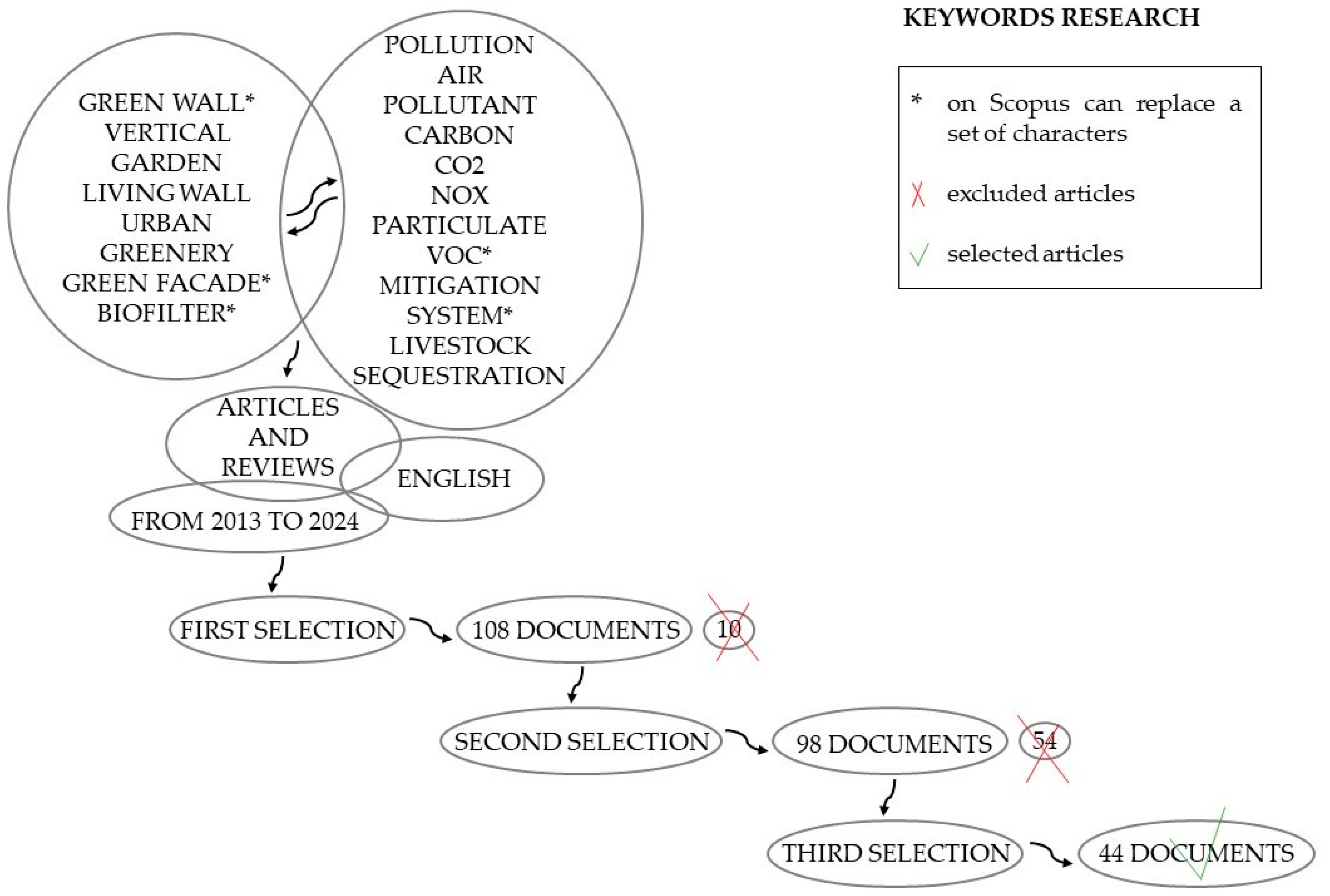
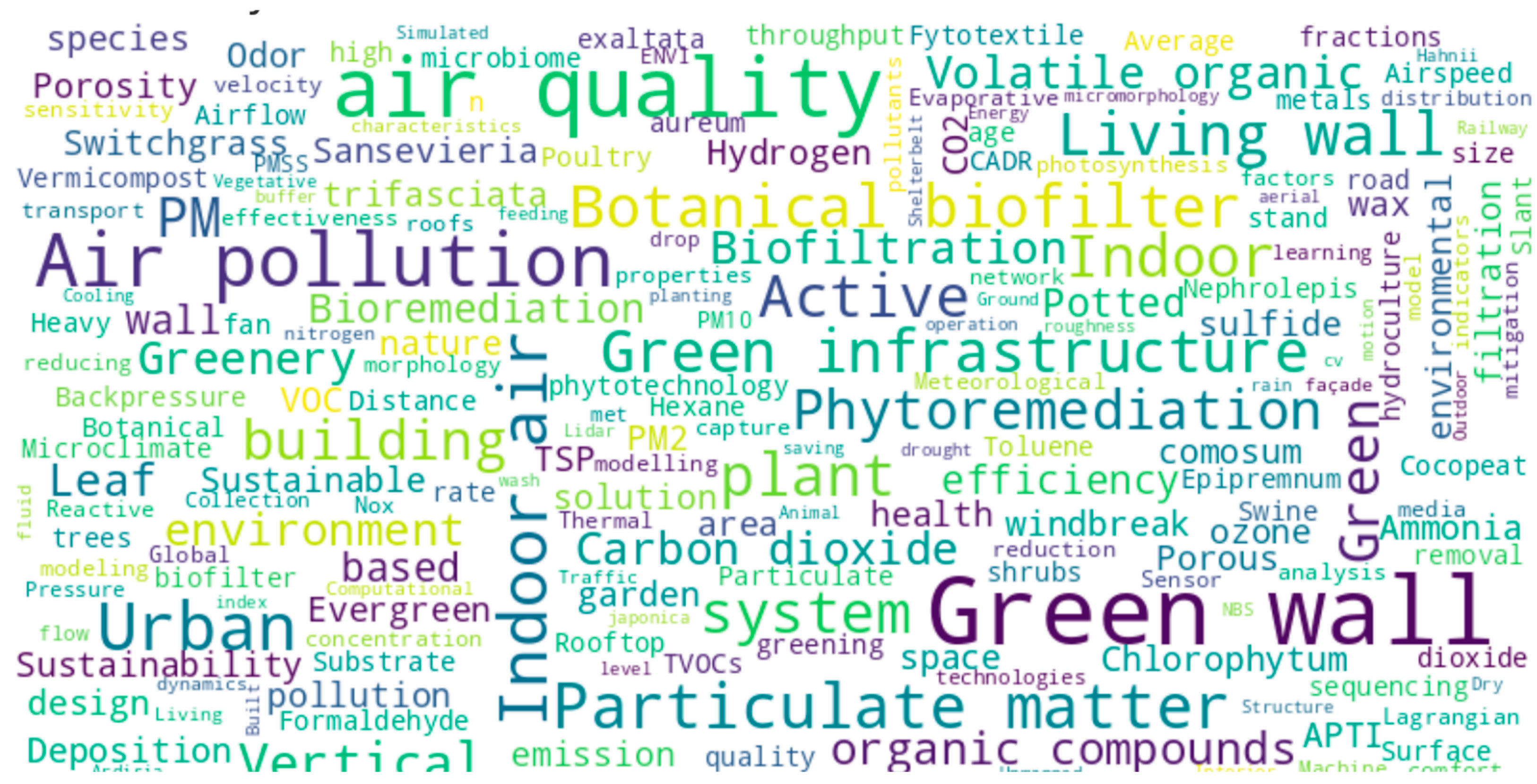
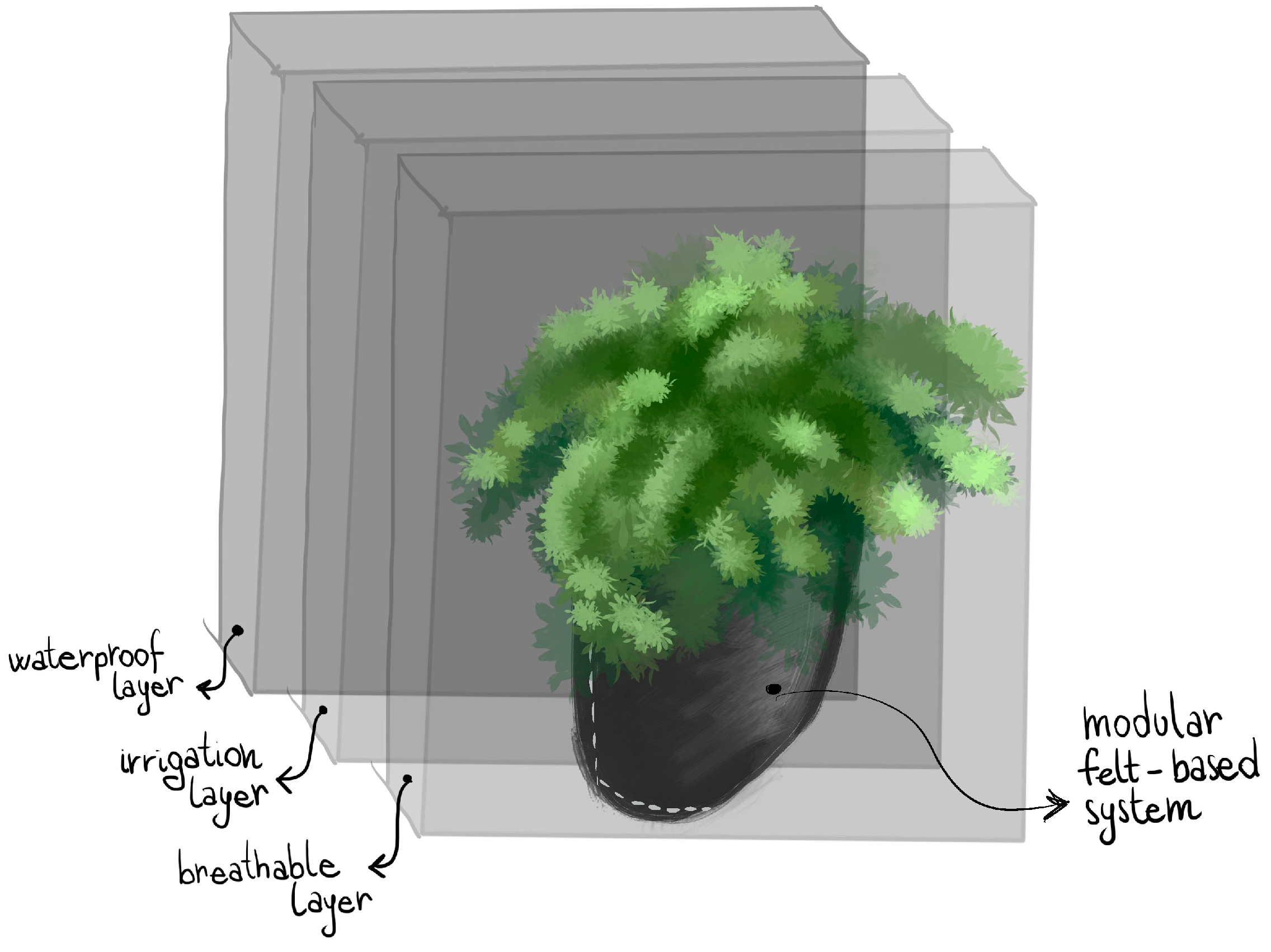
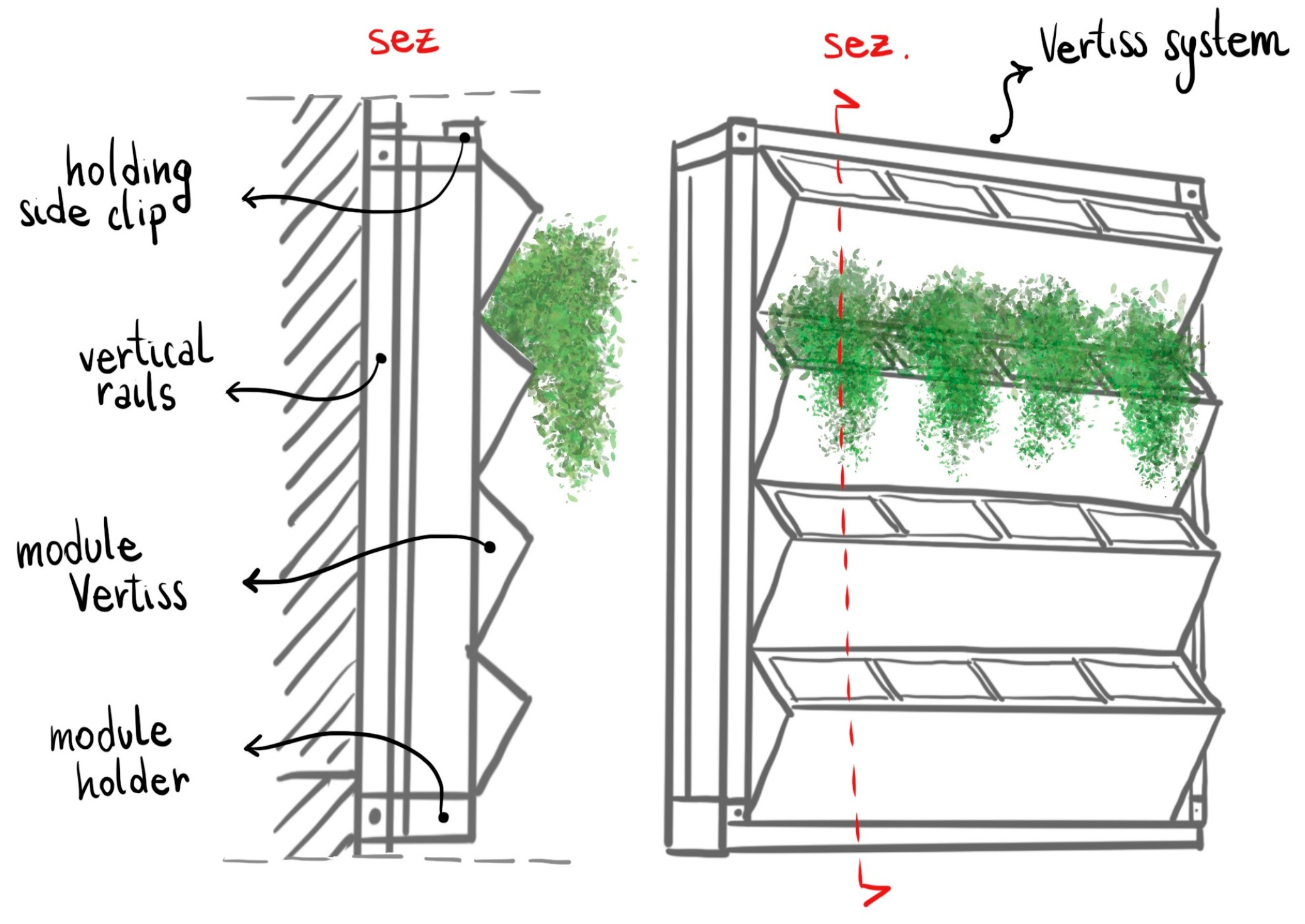
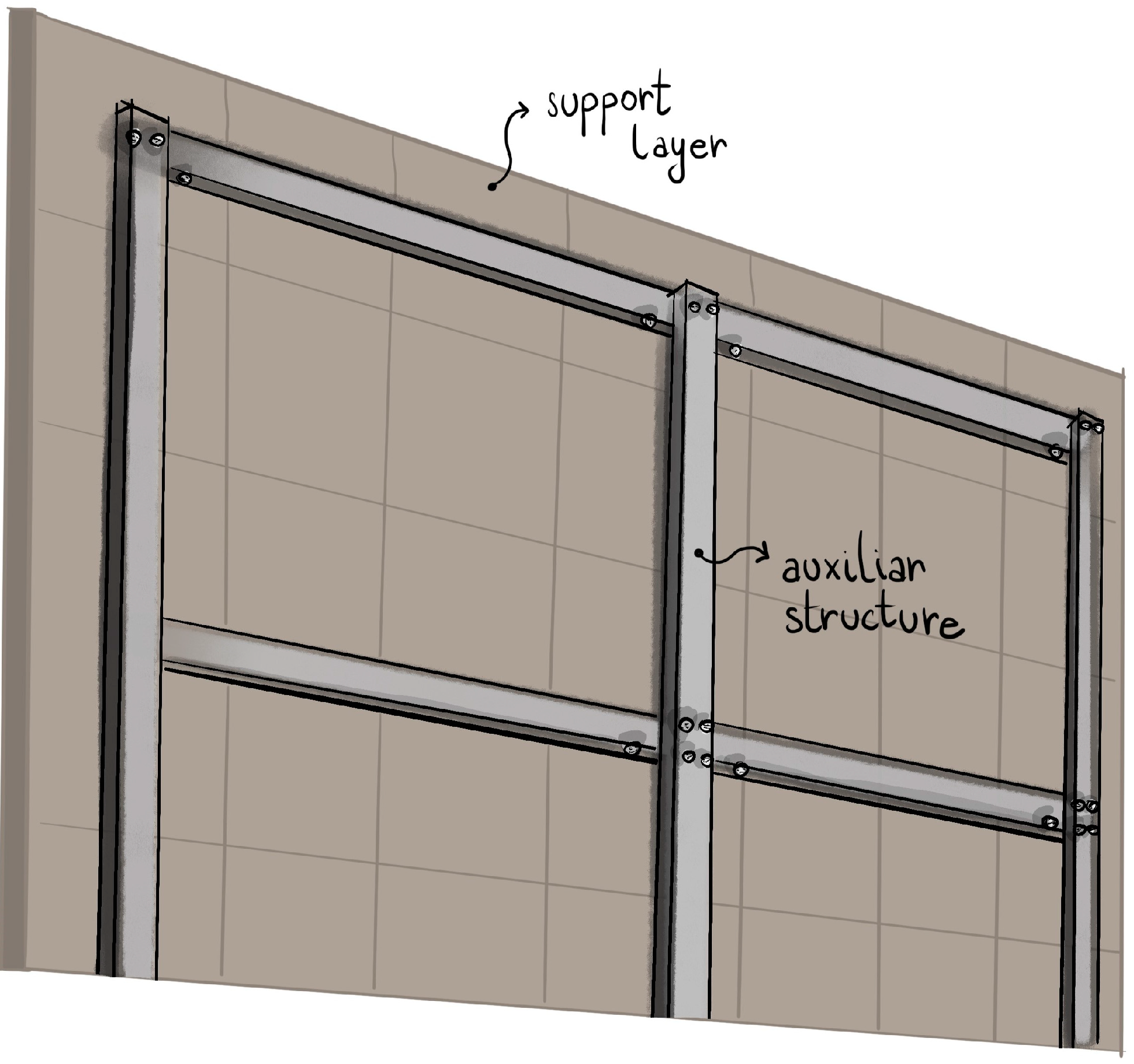
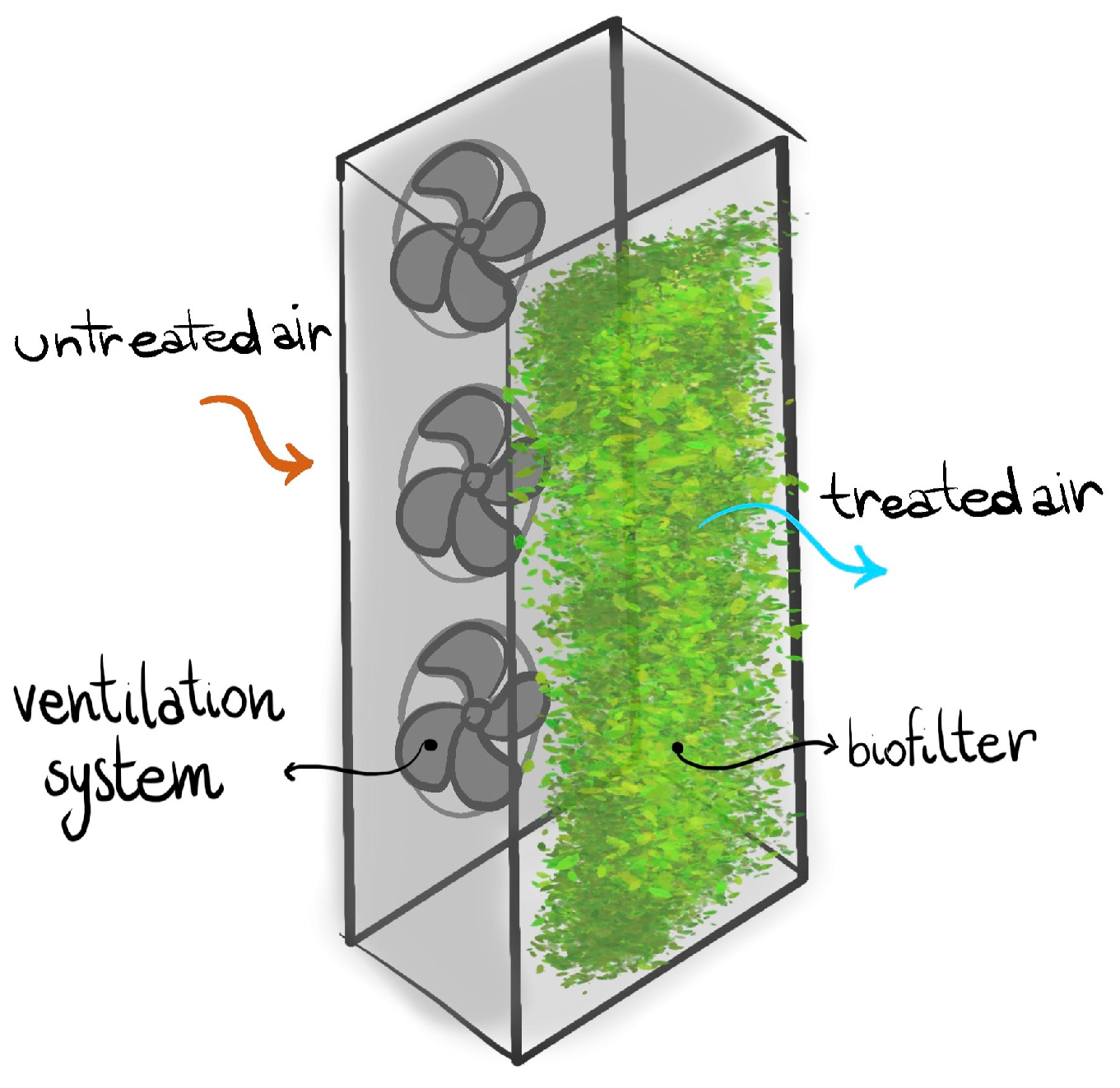

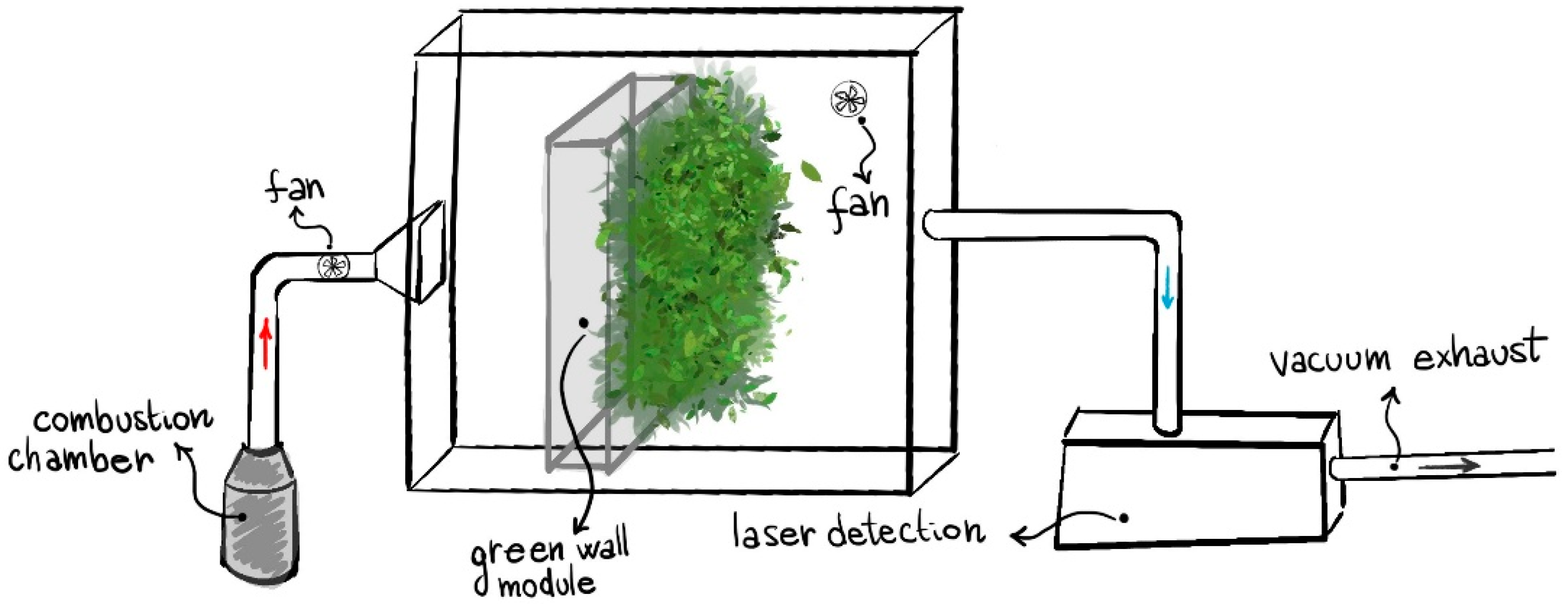
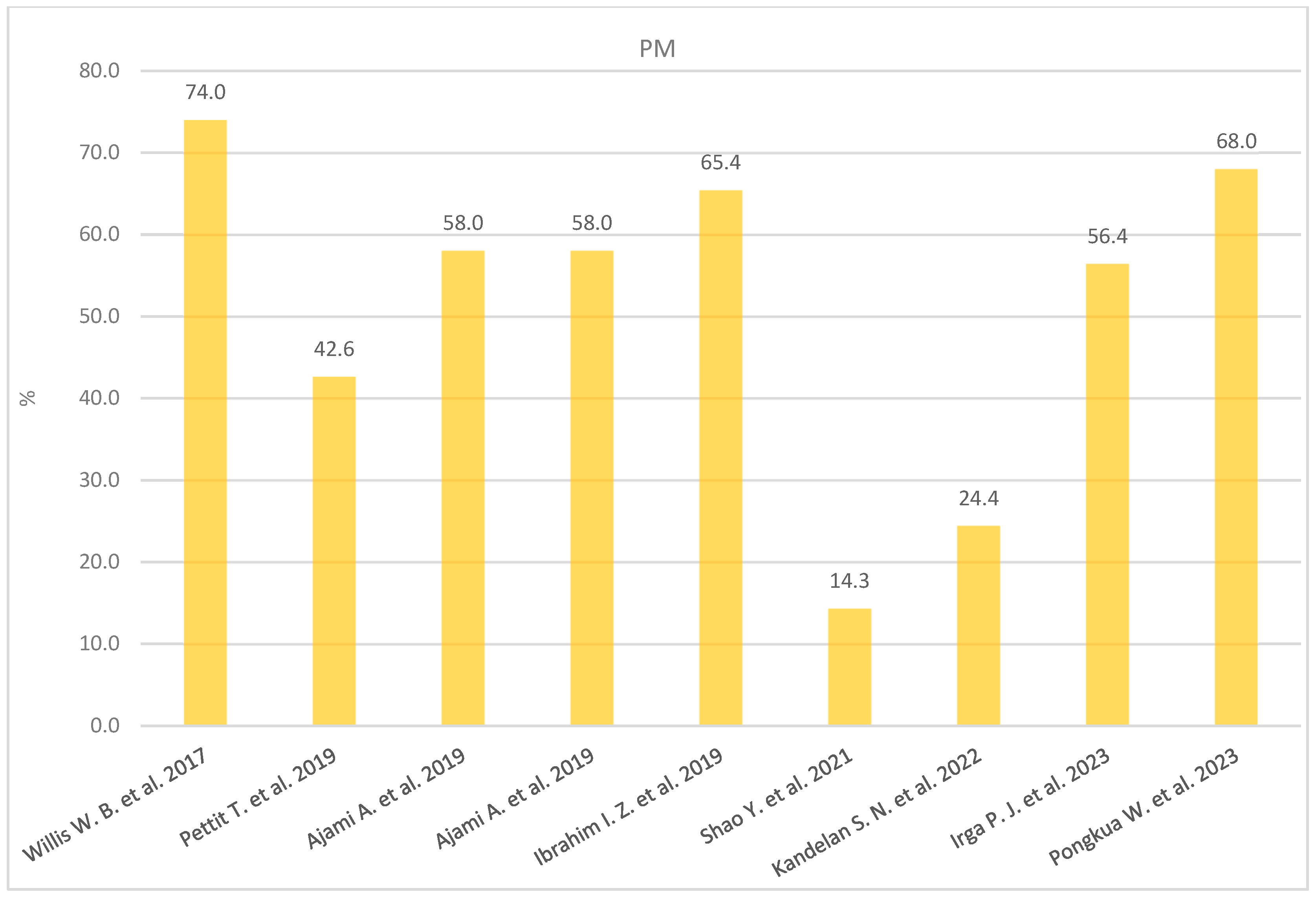
| Authors | Pollutant | Construction Type | Vegetation | Growing Medium | Performance Metrics |
|---|---|---|---|---|---|
| Suarez-Caceres et al. [17] | VOC | Semi-hydroponic | Nephrolepis exaltata L. | Coconut fibre and peat | Significant reduction in VOCs, specific metrics not provided |
| Shushunova et al. [18] | VOC | Hydroponic, modular, container | Gerbera jamesonii, Hedera helix, Dracaena marginata, etc. | Fytotextile, pozzolan, rockwool, soil | Efficiency varies by system type and plant species |
| Hozhabralsadat et al. [19] | PM | Container | Rosmarinus officinalis, Lavandula angustifolia, Carpobrotus edulis, etc. | Soil | Effective in PM reduction, specific metrics not provided |
| Weerakkody et al. [20] | PM | Modular freestanding | Acorus gramineus Sol., Berberis buxifolia Lam., Bergenia cordifolia, etc. | Soil | Effective in PM reduction, specific metrics not provided |
| Shao et al. [22] | PM, CO2 | Container | Schefflera octophylla Harms, Fatsia japonica Decne. et Planch, etc. | Soil | CO2 reduction: 12–17%, PM reduction: Specific metrics needed |
| Yungstein and Helman [23] | CO2 | Hydroponic | Peperomia obtusifolia, Tradescantia spathacea, Chlorophytum comosum, etc. | Cloth | CO2 absorption: 4.8% without assisted ventilation |
| Viecco et al. [24] | PM | - | Platanus acerifolia, Robinia pseudoacacia, Palma washingtonia, etc. | - | Effective in PM reduction, specific metrics not provided |
| Authors | Pollutant | Construction Type | Vegetation | Growing Medium | Performance Metrics |
|---|---|---|---|---|---|
| Wu and Yu [25] | VOC | Modular | Chlorophytum comosum, Schefflera octophylla, Chamaedorea elegans | - | High formaldehyde removal efficiency |
| Abdo et al. [26] | PM, VOC, CO2 | Modular | Chlorophytum comosum ‘Variegatum’, Schefflera arboricola | Coconut husks and fibre | Increased airflow efficiency, high VOC and CO2 reduction |
| Ibrahim et al. [27] | PM, VOC | Modular freestanding | Epipremnum aureum | Soil | High efficiency in PM and VOC reduction |
| Torpy et al. [28] | CO2 | Modular | Neomarica sp., Philodendron xanadu, Peperomia sp., etc. | Coconut fibre | High CO2 reduction, effective at low light |
| Pongkua et al. [29] | PM, VOC | Modular | Sansevieria trifasciata | Soil and coconut chip | Effective PM and VOC reduction |
| Pettit et al. [10] | NO, NO2, O3 | - | Spathiphyllum wallisii, Syngonium podophyllum | Coconut husk | High NOx and O3 reduction efficiency |
| Irga P. J. et al. [32] | PM, O3, NO2 | Modular freestanding | Philodendron scandens | Coconut husk | High reduction of O3, NO2, and PM |
| Authors | Pollutant | Vegetation | Performance Metrics |
|---|---|---|---|
| Grzędzicka [40] | PM, CO2 | Betula spp., Fagus spp., Carpinus spp., Quercus spp., etc. | Effective PM and CO2 reduction, specific metrics not provided |
| Srbinovska et al. [41] | PM | Hedera helix | Effective PM reduction, specific metrics not provided |
| Kandelan et al. [42] | PM | Agave victoriae-reginae, Einadia nudans, Ophiopogon japonicus | Effective PM reduction, specific metrics not provided |
| Motie et al. [43] | PM | Deciduous, coniferous, hedge, grass | Effective PM reduction, specific metrics not provided |
| Ma et al. [44] | PM | Hawthorn hedge, conifers | Effective PM reduction, specific metrics not provided |
| Kaspar et al. [45] | PM, O3 | Acer negundo, Acer pseudoplatanus, Alnus glutinosa, etc. | High O3 and PM reduction efficiency |
| Willis et al. [46] | PM | Taxodium distichum, Thuja plicata x standishii, Pinus strobus | Effective PM reduction, specific metrics not provided |
| Guo et al. [47] | PM | Winged Euonymus, Padus maackii, Malus spectabilis, etc. | High PM capture efficiency |
| Authors | Pollutant | Construction Type | Vegetation | Growing Medium | Performance Metrics |
|---|---|---|---|---|---|
| Mikkonen et al. [48] | VOC | Potted plants | Epipremnum pinnatum cv. aureum, Davallia fejeensis Hook | Soil | High VOC reduction efficiency |
| Agra et al. [49] | CO2 | Potted plants | Chlorophytum comosum, Epipremnum aureum | - | High CO2 absorption efficiency |
| Kazemi et al. [59] | PM | Transparent plastic container | Peperomia magnoliiaefolia, Kalanchoe blossfeldiana, etc. | Cocopeat, perlite, vermicompost | High PM reduction efficiency |
| Shen et al. [51] | VOC | Modular | Money tree, Staghorn fern, Chinese Evergreen, etc. | Cloth | High VOC reduction efficiency |
| Pettit et al. [52] | PM | Modular | Chlorophytum orchidastrum, Ficus lyrata, Nematanthus glabra, etc. | Soil | High PM reduction efficiency |
| Weerakkody et al. [53] | PM | - | Geranium macrorrhizum L., Hedera helix L. ivy, Hebe albicans, etc. | Soil | High PM reduction efficiency |
| Przybysz et al. [54] | PM, TE | - | Taxus baccata L., Pinus nigra Arn., Carpinus betulus | - | High PM and TE accumulation |
| Pandey et al. [55] | PM, O3, SO2, NO2 | - | Ipomoea palmata, Aristolochia elegans, Thunbergia grandiflora, etc. | - | High pollutant tolerance and reduction efficiency |
| Paull et al. [56] | PM | - | Chlorophytum comosum, N. glabra, N. exaltata ‘Bostoniensis’, etc. | - | High PM reduction efficiency |
| Treesubsuntorn and Thiravetyan [57] | CO2 | Potted plants | S. kurkii, S. trifasciata, C. comosum, D. sanderiana, etc. | Sandy loam soil mixture | High CO2 absorption efficiency |
| Choi et al. [58] | PM | - | Ardisia japonica, Hedera helix | Organic soil and rice husk-derived |
| Authors | Pollutant | Green System | Construction Type | Test Site | Pollutant Detection | Duration | Specific Conditions | Performance Metrics |
|---|---|---|---|---|---|---|---|---|
| Irga et al. [32] | PM, O3, NO2 | Active Green Wall | Modular | Indoor | AQY1 micro air quality monitoring systems | 42 days | High localized pollutant levels, temperature, humidity | High removal efficiency for O3 and PM, lower for NO2 |
| Pettit et al. [36] | PM, VOC | Active Green Wall | Modular | Indoor | Photoionization detector (PID) | 32–37 min | Residential room, 20–25 °C | Significant reduction in PM and VOC compared to HVAC system |
| Shao et al. [22] | PM, CO2 | Green Wall | Container | Indoor | Air quality monitor (BohuBH-03) | Continuous | Stairwell of an office building | CO2 reduction: 12–17%, PM reduction: 2.4–14.3% |
| Villani et al. [34] | PM, NO, NO2, NOx | Active Green Wall | Modular | Outdoor | Condensation particle counter, gas analyzer | 12 days | Urban context, multiple measurement points | Greatest reduction near the green wall |
| Grzędzicka [40] | PM, CO2 | Urban Greenery System | - | Outdoor | Air Quality Monitor SDL607, Air Display CO-60 | 5 months | Urban park, consistent weather conditions | Pollutant concentrations increase with distance from system |
| Srbinovska et al. [41] | PM | Urban Greenery System | - | Outdoor | Wireless Sensor Network | Continuous | Urban area with trees, shrubs, buildings, parking lot | Lowest concentrations near the green wall |
| Kaspar et al. [45] | PM, O3 | Urban Greenery System | - | Outdoor | Alphasense sensors OPC-N3, Cairsens sensors | Continuous | Residential area, urban forest, varying temperature and radiation | PM reduction: 0.00–0.28 g/m2 per ppb, O3 reduction: 0.00–0.16 g/m2 per ppb |
| Ajami et al. [38,39] | PM, C, N, S | Windbreak Wall-Vegetative Strip System | Box | Livestock buildings | Gravimetric TSP sampler | Continuous | Pig farm and poultry house, varying screen porosity | TSP reduction: 36–58%, reduced ammonia emissions and odor |
| Willis et al. [46] | PM | Vegetative Environmental Buffer | - | Livestock buildings | Lidar, low-volume TSP sampler heads | Continuous | Poultry houses, rows of trees and hedges | PM capture efficiency varies between day and night |
| Authors | Pollutant | Green System | Test Site | Pollutant Detection Method | Performance Metrics |
|---|---|---|---|---|---|
| Pettit et al. [52] | PM | Plant species | Indoor | Laser nephelometer (Graywolf PC-3016A)—GrayWolf Sensing Solutions, Shelton, CT, USA | PM reduction: 65% |
| Pettit et al. [30] | PM, VOC | Active green wall | Indoor | Photoionization detector (ppbRAE 3000)—RAE Systems, San Jose, CA, USA | PM reduction: 54%, VOC reduction: 48% |
| Pettit et al. [31] | VOC | Active green wall | Indoor | Photoionization detector (ppbRAE 3000)—RAE Systems, San Jose, CA, USA | VOC removal: 19.76–96.34% |
| Pettit et al. [10] | NO, NO2, O3 | Active green wall | Indoor | Ecotech EC9841 nitrogen oxides analyser; Ecotech Serinus 10 ozone analyser—Ecotech, Knoxfield, Victoria, Australia | NO reduction: 50%, NO2 reduction: 45%, O3 reduction: 60% |
| Wu and Yu [25] | VOC | Active green wall | Indoor | Gas samplers (Laoying 2020 Model)—Qingdao Laoshan Electronic Instrument Co., Ltd., Qingdao, China | Formaldehyde removal: 75% |
| Mikkonen et al. [48] | VOC | Plant species | Indoor | GC-MS (Hewlett-Packard 6890 GC/5973 MSD)—Hewlett-Packard (now Agilent Technologies), Santa Clara, CA, USA | VOC reduction: 85% |
| Agra et al. [49] | CO2 | Plant species | Indoor | Portable gas exchange system (Walz GFS-3000)—Heinz Walz GmbH, Effeltrich, Germany | CO2 absorption: 70% |
| Pandey et al. [55] | PM, O3, SO2, NO2 | Plant species | Outdoor | Respirable dust sampler (Envirotech APM460-NL); Modified method of Jacob and Hochheiser; Improved West and Gaeke Method: Sulfur Dioxide—Envirotech Instruments Pvt. Ltd., New Delhi, India | PM reduction: 40%, O3 reduction: 35%, SO2 reduction: 30%, NO2 reduction: 25% |
| Hozhabralsadat et al. [19] | PM, HM | Plant species | Outdoor | Particle analyzer (ImageJ)—National Institutes of Health (NIH), Bethesda, MD, USA | PM reduction: 50%, HM reduction: 45% |
| Paull et al. [56] | PM | Plant species | Outdoor | Dry gravimetric technique of Das and Pattanayak | PM reduction: 60% |
| Suarez-Caceres et al. [17] | VOC | Green wall | Indoor | PCE-VOC 1 gas detector—PCE Instruments, Meschede, Germany | VOC reduction: 55%, long-term decline to 30% |
| Shen et al. [51] | VOC | Plant species | Indoor | - | Initial VOC reduction: 50%, decline after 24–48 h to 20% |
| Choi et al. [58] | PM, VOC, CO2 | Plant species | Indoor | Sensor-based instrument (Smart Aircok)—Smart Air, Beijing, China | PM reduction: 40%, VOC reduction: 45%, CO2 reduction: 50% |
| Abdo et al. [26] | PM, VOC, CO2 | Active green wall | Indoor | - | PM reduction: 35%, VOC reduction: 40%, CO2 reduction: 45% |
| Pongkua et al. [29] | PM, VOC | Active green wall | Indoor | Air quality detector (BR-8A), VOC monitor (Lanbao Deyuan)—Shanghai Lanbao Sensing Technology Co., Ltd., Shanghai, China | PM reduction: 50%, VOC reduction: 55% |
| Yungstein and Helman [23] | CO2 | Green wall | Indoor | Infrared gas analyzer (LI-6800)—LI-COR Biosciences, Lincoln, NE, USA | CO2 absorption: 60% under varying light conditions |
| Treesubsuntorn and Thiravetyan [57] | PM, VOC, CO2 | Plant species | Indoor | Multi-parameter analyser (model AZ-7752)—AZ Instrument Corp., Taichung City, Taiwan | PM reduction: 45%, VOC reduction: 40%, CO2 reduction: 50%, increased efficiency with light |
| Torpy et al. [28] | CO2 | Active green wall | Indoor | Portable Infra-Red Gas Analyser (IRGA)—PP Systems, Amesbury, MA, USA | CO2 reduction: 65% |
| Torpy et al. [33] | VOC | Active green wall | Indoor | TSI Venturi model No: 2017 inline venturi—TSI Incorporated, Shoreview, MN, USA | VOC removal: 55% |
| Ibrahim et al. [27] | PM, VOC | Active green wall | Indoor | Laser scattering (TSI 8530 DustTrak)—TSI Incorporated, Shoreview, MN, USA; Gas chromatography (GC)—Agilent Technologies, Santa Clara, CA, USA | PM reduction: 54%, VOC reduction: 46% |
| Weerakkody et al. [21] | PM | Plant species | Outdoor | Particle analyzer (ImageJ) | PM removal by rain: 50% |
| Weerakkody et al. [53] | PM | Plant species | Outdoor | Environmental Scanning Electron Microscope (ESEM), ImageJ—FEI Company, Hillsboro, OR, USA | PM removal: 60% |
| Weerakkody et al. [20] | PM | Green wall | Outdoor | Environmental Scanning Electron Microscope (ESEM)—FEI Company, Hillsboro, OR, USA | PM reduction: 55% |
| Weerakkody et al. [60] | PM | Green wall | Outdoor | Environmental Scanning Electron Microscope (ESEM), ImageJ—FEI Company, Hillsboro, OR, USA | Positive impact of morphological diversity on PM removal: 45% |
| Przybysz et al. [54] | PM, TE | Plant species | Outdoor | Image Analysis System (Skye Instruments Ltd.),—Skye Instruments Ltd., Llandrindod Wells, UK | PM reduction: 50%, TE reduction: 40% |
| Authors | Pollutant | Green System | Setting | Simulation Modeling Tools | Initial Conditions | Boundary Conditions | Assumptions | Validation |
|---|---|---|---|---|---|---|---|---|
| Masi et al. [35] | VOC | Active green wall | Indoor | Python open-source platform using FEniCS software version 2016.2 | Ambient pollutant concentrations, flow rates | Environmental parameters | Homogeneous vegetation properties, steady-state conditions | Compared with real-world data from Pettit et al. [36] |
| Ajami et al. [37] | PM | Windbreak Wall–Vegetative Strip | Livestock | Computational fluid dynamics (CFD) software, FloEFD version 17.2 | Pollutant concentrations, airflow velocity | Airflow velocity and direction, screen porosity | Uniform pollutant distribution, constant environmental conditions | Compared with field study results [38,39] |
| Ma et al. [44] | PM | Urban greenery system | Outdoor | ANSYS Fluent package, ICEM CFD version 15.0 | Pollutant concentrations, airflow velocity | Inlet and outlet airflow characteristics, porous zone for barrier | Steady-state conditions, homogeneous vegetation properties | Compared with experimental data from urban field tests |
| Viecco et al. [24] | PM | Green wall | Outdoor | ENVI-met software | Pollutant concentrations, meteorological data | Urban environmental parameters | Idealized urban configuration, steady-state conditions | Compared with real-world air quality data |
| Motie et al. [43] | PM | Urban greenery system | Outdoor | ENVI-met software | Meteorological data from spring and summer, pollutant levels | Meteorological parameters | Steady-state conditions, homogeneous vegetation properties | Validated against experimental air quality measurements |
| Kandelan et al. [42] | PM | Urban greenery system | Outdoor | ENVI-met software | Pollutant concentrations, wind patterns | Urban layout, wind direction | Homogeneous vegetation properties, steady-state conditions | Field data on air quality and pollutant deposition |
| Villani et al. [34] | PM, NO, NO2, NOx | Active green wall | Outdoor | Micro-SWIFT-SPRAY (PMSS) modeling system | Measured pollutant levels, meteorological data | Meteorological parameters, pollutant emission rates | Steady-state conditions, homogeneous vegetation properties | Simulated results compared with experimental observations |
Disclaimer/Publisher’s Note: The statements, opinions and data contained in all publications are solely those of the individual author(s) and contributor(s) and not of MDPI and/or the editor(s). MDPI and/or the editor(s) disclaim responsibility for any injury to people or property resulting from any ideas, methods, instructions or products referred to in the content. |
© 2024 by the authors. Licensee MDPI, Basel, Switzerland. This article is an open access article distributed under the terms and conditions of the Creative Commons Attribution (CC BY) license (https://creativecommons.org/licenses/by/4.0/).
Share and Cite
Vitaliano, S.; Cascone, S.; D’Urso, P.R. Mitigating Built Environment Air Pollution by Green Systems: An In-Depth Review. Appl. Sci. 2024, 14, 6487. https://doi.org/10.3390/app14156487
Vitaliano S, Cascone S, D’Urso PR. Mitigating Built Environment Air Pollution by Green Systems: An In-Depth Review. Applied Sciences. 2024; 14(15):6487. https://doi.org/10.3390/app14156487
Chicago/Turabian StyleVitaliano, Serena, Stefano Cascone, and Provvidenza Rita D’Urso. 2024. "Mitigating Built Environment Air Pollution by Green Systems: An In-Depth Review" Applied Sciences 14, no. 15: 6487. https://doi.org/10.3390/app14156487







